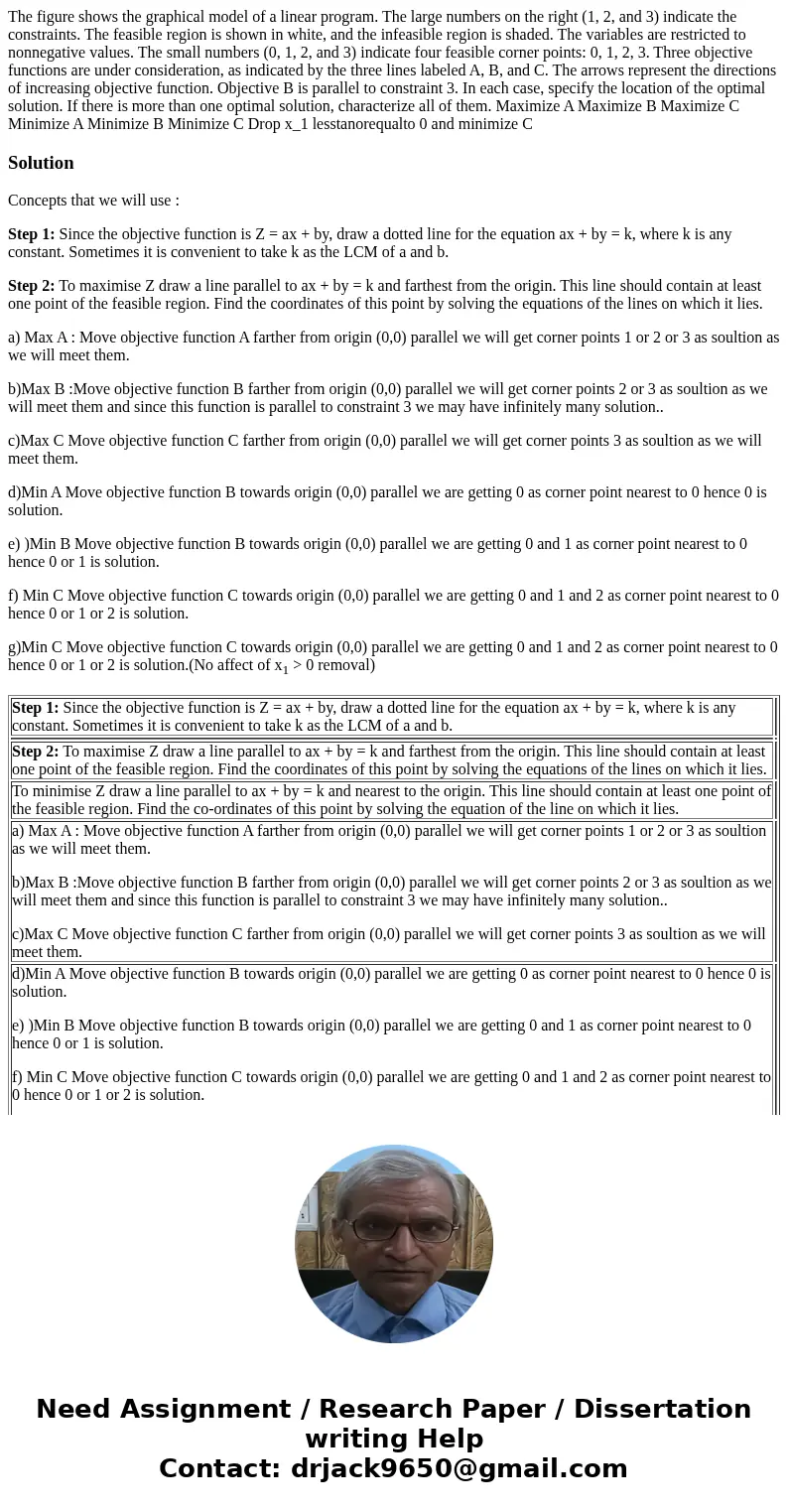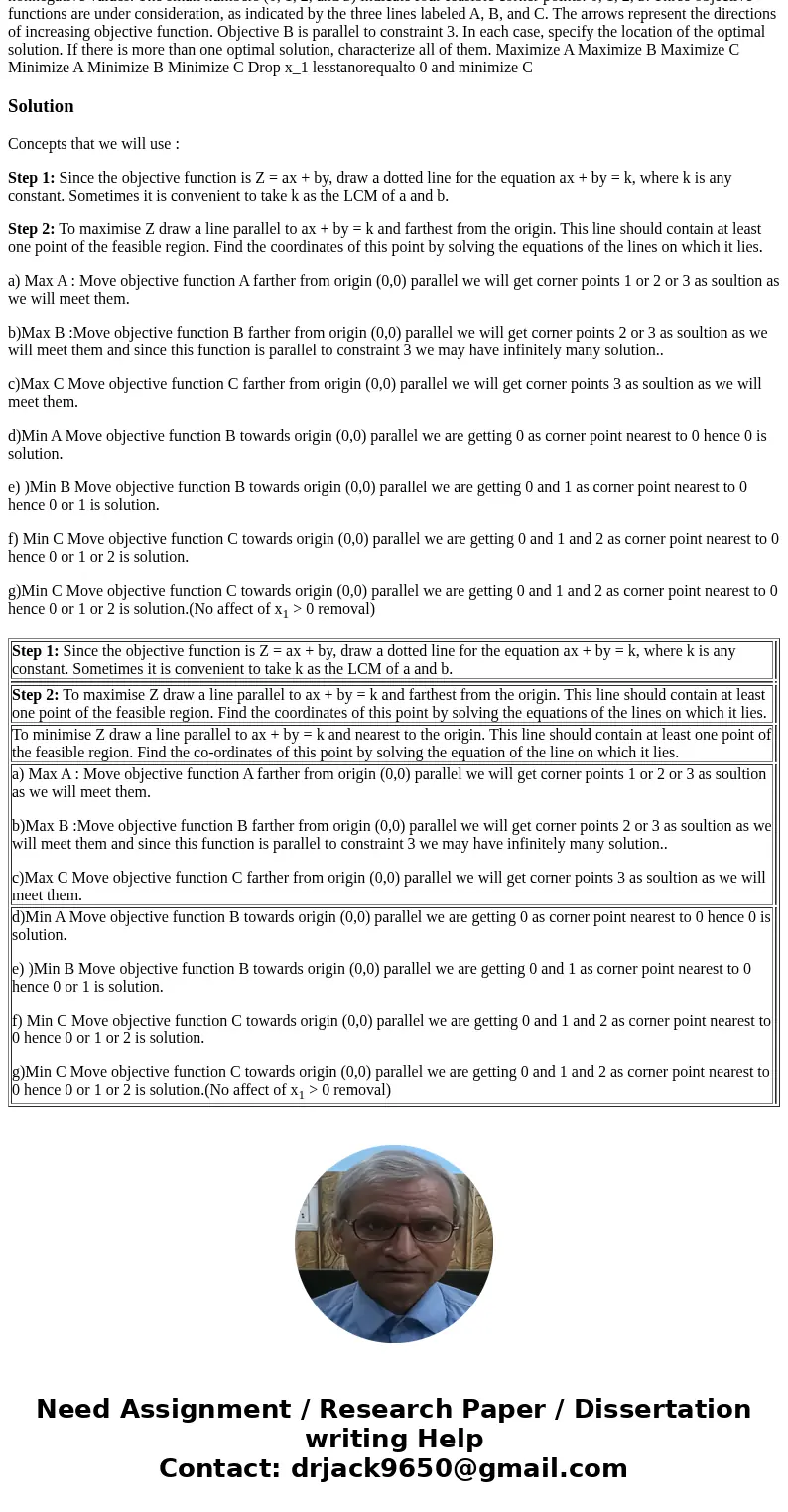The figure shows the graphical model of a linear program The
Solution
Concepts that we will use :
Step 1: Since the objective function is Z = ax + by, draw a dotted line for the equation ax + by = k, where k is any constant. Sometimes it is convenient to take k as the LCM of a and b.
Step 2: To maximise Z draw a line parallel to ax + by = k and farthest from the origin. This line should contain at least one point of the feasible region. Find the coordinates of this point by solving the equations of the lines on which it lies.
a) Max A : Move objective function A farther from origin (0,0) parallel we will get corner points 1 or 2 or 3 as soultion as we will meet them.
b)Max B :Move objective function B farther from origin (0,0) parallel we will get corner points 2 or 3 as soultion as we will meet them and since this function is parallel to constraint 3 we may have infinitely many solution..
c)Max C Move objective function C farther from origin (0,0) parallel we will get corner points 3 as soultion as we will meet them.
d)Min A Move objective function B towards origin (0,0) parallel we are getting 0 as corner point nearest to 0 hence 0 is solution.
e) )Min B Move objective function B towards origin (0,0) parallel we are getting 0 and 1 as corner point nearest to 0 hence 0 or 1 is solution.
f) Min C Move objective function C towards origin (0,0) parallel we are getting 0 and 1 and 2 as corner point nearest to 0 hence 0 or 1 or 2 is solution.
g)Min C Move objective function C towards origin (0,0) parallel we are getting 0 and 1 and 2 as corner point nearest to 0 hence 0 or 1 or 2 is solution.(No affect of x1 > 0 removal)
| Step 1: Since the objective function is Z = ax + by, draw a dotted line for the equation ax + by = k, where k is any constant. Sometimes it is convenient to take k as the LCM of a and b. | |
| Step 2: To maximise Z draw a line parallel to ax + by = k and farthest from the origin. This line should contain at least one point of the feasible region. Find the coordinates of this point by solving the equations of the lines on which it lies. | |
| To minimise Z draw a line parallel to ax + by = k and nearest to the origin. This line should contain at least one point of the feasible region. Find the co-ordinates of this point by solving the equation of the line on which it lies. | |
| a) Max A : Move objective function A farther from origin (0,0) parallel we will get corner points 1 or 2 or 3 as soultion as we will meet them. b)Max B :Move objective function B farther from origin (0,0) parallel we will get corner points 2 or 3 as soultion as we will meet them and since this function is parallel to constraint 3 we may have infinitely many solution.. c)Max C Move objective function C farther from origin (0,0) parallel we will get corner points 3 as soultion as we will meet them. | |
| d)Min A Move objective function B towards origin (0,0) parallel we are getting 0 as corner point nearest to 0 hence 0 is solution. e) )Min B Move objective function B towards origin (0,0) parallel we are getting 0 and 1 as corner point nearest to 0 hence 0 or 1 is solution. f) Min C Move objective function C towards origin (0,0) parallel we are getting 0 and 1 and 2 as corner point nearest to 0 hence 0 or 1 or 2 is solution. g)Min C Move objective function C towards origin (0,0) parallel we are getting 0 and 1 and 2 as corner point nearest to 0 hence 0 or 1 or 2 is solution.(No affect of x1 > 0 removal) |


 Homework Sourse
Homework Sourse